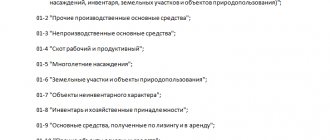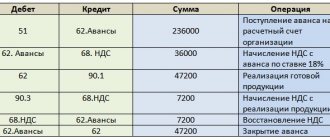The legislation provides that when concluding an agreement between the buyer and the supplier, the latter is obliged to supply the customer with goods, provide a service or perform work in strict accordance with the quantity, quality and assortment provided for in these agreements.
If the above conditions are not met, the buyer has the right to return products that do not meet the requirements, and the supplier undertakes to return the previously paid funds to the customer. This article describes standard transactions that reflect the procedure for refunding funds in the buyer's and supplier's accounts, as well as the documents on the basis of which they are carried out.
Postings for the return of money and goods in the buyer’s accounting department
If significant deficiencies or defects are identified, the buyer may refuse to fulfill the terms of the contract in full and demand the supplier to return the money paid.
In such a situation, the buyer must send a written claim to the supplier to terminate the contractual relationship with a demand for a refund of the money paid.
The seller, in turn, has the right to return the goods refused by the buyer.
If the need to return the goods and money occurred after the buyer had posted material assets, then if the issue of returning the goods and money is resolved positively, entries will be made in the buyer’s accounting department to the appropriate sub-accounts, based on the claim to the seller and the invoice for the returned goods:
- D-t 62 invoices and K-t 90 invoices - for the amount of the returned goods,
- Invoice Dt 90 and Invoice Dt 68 - VAT is charged on the returned goods.
A refund from the supplier (seller) to the buyer’s bank account for a low-quality product (service) or a product of the wrong assortment will look like this:
- D-t 51 invoices and K-t 62 invoices - for the amount of the invoice issued by the buyer for the return of goods.
If the refund by the seller (supplier) was made directly at the buyer's (customer) cash desk, then the posting of the refund will look like a debit of 50 and a credit of 62 accounts.
What if tax periods are different?
According to clause 6 of PBU 9 “Income of the organization”, revenue in accounting is accepted in an amount equal to the amount of funds received. When a return of goods to the supplier is issued, title is deemed not to have passed to the buyer. According to clause 80 of the Russian Accounting Standards, a decrease in revenue after the detection of a defect in the previous year is reflected as a loss for the reporting period. No adjustments are made to the balance sheet. Using the conditions of the previous example, let us consider how the return of goods to the supplier is processed in different tax periods. Postings:
- DT91.2 KT62 - 25,000 - the return from the seller is taken into account as an expense for the reporting year.
- DT41 KT91.1 - 20,000 - written-off cost restored.
- DT68 KT91.1 - 3813.5 - accepted for VAT deduction.
Refund of erroneously (excessively) paid funds
Refunds of funds transferred to the supplier by mistake are made on the basis of a letter from the customer, which indicates the payment document, its number, date and the amount paid by mistake.
The party that received the erroneous amount reconciles the calculations and deliveries. If excess money is discovered, the supplier returns it to the customer.
In the accounting department of the customer (buyer), the erroneously transferred money is reflected in account 76, the corresponding subaccount.
Posting a refund of funds erroneously transferred to the seller to the customer’s bank account will look like:
- D-t 51 accounts and K-t 76 accounts - in the amount of excessively (erroneously) transferred funds.
The return of money through the customer's cash desk is recorded as turnover on the debit of account 50 and the credit of account 76.
Consultation on accounting entries for financial returns can be obtained from organizations specializing in consulting accountants or tax authorities. Qualified employees of these organizations will answer any questions you may have regarding accounting for the company’s funds.
General requirements
The document is an application (request) for the return of the transferred money. There is no unified form, so we draw up a free application. Be sure to include the following information:
- details of your organization: the application can be made on company letterhead;
- bank details for refund;
- name of the counterparty's manager, his position and full name;
- subject of the appeal (subject of the claim): indicate on the basis of which document (agreement, invoice agreement, universal transfer document) the letter is drawn up;
- subject of appeal: describe exactly how and as a result of which the money was transferred to the supplier’s bank account. Indicate the basis on which you need to return the money, your requirements for terms, include fines and penalties, if any, in the document that forms the basis of the obligation. Justify your position with the law or terms of the contract, on the basis of which the supplier is obliged to return the funds.
Attach copies of supporting documents: payment slips, bank statements about debits from the account. In the inventory, indicate not only the quantity, but also the number of pages in each of them. In the attachment to the letter, be sure to add a reconciliation act for mutual settlements. Confirm the application with the signatures of: the responsible executive, the financial director (chief accountant) and the head of the organization.
Documentation of refund to the buyer
According to Article 466 of the Civil Code of the Russian Federation, the buyer has the right to return the goods if they are delivered in quantities less than those provided for in the contracts. If there are discrepancies in the assortment, the return is carried out on the basis of Article 468 of the Civil Code of the Russian Federation. If a product is found to be of inadequate quality, the customer issues a return in accordance with Article 475 of the Civil Code of the Russian Federation.
When returning goods, the buyer draws up the following documents:
- A report on identified discrepancies, drawn up in the TORG-2 form (for imported goods - TORG-3 form). This document is drawn up if, upon shipment of the goods and after payment, the customer identifies deviations in the quality or quantity of products, as well as if inconsistencies are detected in the shipping documents.
- Invoice (form TORG-12), which is used to issue a return if a product is found to be defective or the product does not comply with the approved state or contractual standard.
These documents are transferred to the supplier along with a letter of refund, on the basis of which the supplier accepts the products, and the buyer is credited with the previously made prepayment.
Legislation
According to Art. 421 of the Civil Code of the Russian Federation, the supplier can return to the buyer not only damaged, but also good quality goods. The reason may be a lack of demand. This operation is a reverse implementation. The return of expired goods is carried out within the framework of the delivery agreement. The reasons may be:
- Lack of documents.
- Receipt of a smaller quantity or a different assortment of goods (Article 466, Article 468).
- Poor quality of values (Article 475).
- Lack of containers (Article 482).
At the moment of transfer of goods, the buyer receives ownership of them. He may refuse values for the reasons stated above. If discrepancies are identified, the buyer must draw up a “Certificate of Return of Goods to the Supplier,” indicate the claim in it and send it to the seller.
Refunds to the buyer: accounting with the customer and the supplier
Let's consider each wiring option.
Return postings from the supplier
Example:
For convenience, let's look at accounting for a return transaction from a supplier using an example. An agreement was concluded between Phobos LLC and Demos LLC for the supply of paint and varnish products, where Phobos is the supplier and Demos is the buyer. The products were sold at a price of 155,000 rubles. at a cost of 88,000 rubles. "Demos" made 100% payment for the goods. Due to non-compliance with the quality characteristics, Demos returned the entire consignment of goods, having issued a TORG-2 act. Upon the return of the products, Phobos credited the previously paid funds to the Demos bank account.
The following entries were made in the accounting of Phobos LLC:
| Dt | CT | Base | Sum | Document |
| 62 | 90/1 | Reflection of revenue from the sale of paint and varnish products | 155,000 rub. | Packing list |
| 90/2 | 43 | Write-off of the cost of paint and varnish products | 88,000 rub. | Costing |
| 90/3 | 68 VAT | VAT accrual on shipped goods | RUB 23,644 | Packing list |
| 51 | 62 | Payment for products has been received from Demos | 155,000 rub. | Bank statement |
| 68 VAT | 51 | VAT transfer | RUB 23,644 | Packing list |
| 10 | 60 | Accounting for returned goods as part of materials | 88,000 rub. | Statement of Discrepancies |
| 19 | 60 | Accounting for VAT on returned goods | RUB 23,644 | Statement of Discrepancies |
| 68 VAT | 16 | Acceptance of returned goods for deduction | RUB 23,644 | Statement of Discrepancies |
| 60 | 51 | LLC "Demos" returned previously paid funds | 155,000 rub. | Discrepancy report, refund letter |
| 91/2 | 60 | Recognition of other expenses (RUB 155,000 - RUB 23,644 - RUB 88,000) | RUB 43,356 | Discrepancy report, delivery note, cost calculation |
Buyer's accounting
To understand what transactions are necessary to reflect the return of funds from the buyer, consider the following example:
According to the agreement, LLC “Faza” supplies LLC “Vector” with goods and materials in the amount of 24 pieces in the amount of 64,000 rubles, VAT 9,762 rubles. Upon delivery, 4 units of goods were found to be defective and were returned to Phase. The cost of defective goods and materials was credited to Vector's account.
The accountant of Vector LLC made the following entries:
| Dt | CT | Description | Sum | Document |
| 60/1 | 51 | Vector LLC paid 100% advance for the goods | 64,000 rub. | Payment order |
| 41 | 60/1 | Inventory items are registered | RUR 54,238 | Packing list |
| 19/3 | 60/1 | VAT accounting | RUB 9,762 | Packing list |
| 68 VAT | 19/3 | VAT deductible | RUB 9,762 | Invoice |
| 76/2 | 41/1 | The defective goods were returned to Faza LLC (4 units) | RUB 9,040 | Statement of Discrepancies |
| 76/2 | 68 VAT | VAT has been restored from the cost of the returned goods | RUB 1,627 | Statement of Discrepancies |
| 51 | 76/2 | A refund was received from Faza LLC for defective products | RUB 10,667 | Bank statement |
It is important to know that if a product discrepancy is identified, refunds for low-quality products are carried out only if all necessary documents are completed in full and correctly.
How to issue a refund via an online cash register: sample receipt, document flow, rules
Constituent documents, "Cash receipt order" (KO-1), 50 76-3 Receipt of cash: - from equity participation in other organizations. - on account of profits received from joint activities, Decision of participants, shareholders' meetings, "Cash receipt order order" (KO-1) 50 76-2 Receipt of the amount of claims to the organization's cash desk. »
Receipt cash order" (KO-1) 50 79 Receipt of cash from a separate division of the enterprise.
“Cash receipt order” (KO-1) 50 91-1 Sale for cash of fixed assets and other assets. “Cash receipt order” (KO-1) KKM check. 50 91-1 Reflection of positive exchange rate differences (based on changes in the ruble exchange rate against foreign currency held at the organization’s cash desk).
Accounting certificate-calculation 70 50 Issuance of wages from the cash register.
“Cash expenditure order” (KO-2), “Payroll” (T-53).
Forgiveness of an interest-free loan: we charge personal income tax According to the rules in force from 01/01/2016, when issuing an interest-free loan to an employee, personal income tax must be calculated on a monthly basis from the individual’s benefit from saving on interest.
The question arises: what to do with the already accrued tax amounts in the case when the lender forgives the borrower the entire amount of the loan issued. <... Paying tax “for that guy” - a taxpayer’s passport is not required. According to the current rules, you can pay tax not only for yourself, but also for another taxpayer (including an individual). To do this, you just need to fill out the payment form correctly. There is no need to submit any additional documents to the bank. < … Home → Accounting consultations → Accounting Current as of: September 22, 2021
In one of the consultations, we discussed general issues of synthetic and analytical accounting of cash transactions.
One of them is attached to the product report, and the other is given to the buyer and is the basis for receiving money from the cash register. 2
Next, on the check that was previously issued at the same cash desk, sign the director of the organization (deputy).
Then the check needs to be pasted on a piece of paper and handed over to the accounting department. 3
Record the amount paid for a returned customer or unused cash receipt in the cashier-operator's book.
As a result, the amount of revenue for a given day is reduced by the amount received. 4 If the goods are returned not on the day of purchase, but a day later, then the money is returned from the organization’s main cash register, but solely on the basis of a written application from the buyer, indicating his data, and upon presentation of a document that proves his identity.
Accounting entries 50-1 62, 76, 90-1 Reduced by reversing cash register revenue due to the return of money to buyers (clients) on unused cash receipts (including erroneously punched cash receipts) Accounting accounts used in the entries
- 50 — Cash deskAccount 50 “Cash desk” is intended to summarize information about the availability and flow of funds in the organization’s cash desks. Subaccount 50-1 “Cash of the organization” records the funds in the cash desk of the organization. When an organization...
- 62 — Settlements with buyers and customersAccount 62 “Settlements with buyers and customers” is intended to summarize information on settlements with buyers and customers.
Author KakSimply! Situations often arise in the business activities of an organization that sells goods for cash when a dissatisfied buyer returns the goods.
These operations must be “carried out through the cash register”, while strictly observing the procedure for preparing the primary documents.
According to the Law “On the Protection of Consumer Rights”, the buyer has the right to return the product if it suddenly does not fit in size, configuration, style or turns out to be of poor quality. Articles on the topic: Instruction 1 If the buyer, for one reason or another, is already disappointed in it on the day of purchasing the product and decides to return it, then you are obliged to accept it. Document acceptance of the goods with a return certificate in accordance with Form N KM-3, which requires the details of the cash receipt. Draw up the document in one copy and submit it to the accounting department. In addition, issue a delivery note (in two copies).
>Return of cash to the buyer using a posting check Mikhail Obukhov | Labor Law | 03/08/2018 00:20 0 Comments
Your right
According to paragraph 4 of Article 30 of the Federal Law of May 8, 2021 No. 83-FZ “On Amendments to Certain Legislative Acts of the Russian Federation in Connection with the Improvement of the Legal Status of State (Municipal) Institutions,” transactions with funds of budgetary institutions are accounted for according to the classification codes of operations of the general government sector .
Note! Incoming and outgoing cash orders, reflecting the movement of cash documents, are registered in the Journal of Registration of Incoming and Outgoing Cash Documents (form 0310003), but separately from cash transactions.
Options for errors requiring a refund and their consequences
In relations between counterparties, errors in the transfer of funds are possible, associated with:
- with the wrong choice of counterparty when generating a payment order;
- indicating an incorrect payment amount;
- reflection in the purpose of payment of the details of a document that does not exist in the relationship.
Such errors can be identified by any of the parties, but will require a mandatory written expression of the initiative of the payer of funds to take actions carried out in connection with their correction.
In a number of situations, the error can be corrected by adjusting the purpose of the payment if, for example, there is a supplier-buyer relationship between the counterparties, against which an erroneously transferred amount (or a payment with an incorrectly specified purpose) may be taken into account. Correction via payment adjustment cannot be applied if there are no current engagement agreements with the payee.
Regardless of the reason for which the payment was considered to have been made without reason, it is recorded by both the payer and the recipient using the same algorithms, taking into account the fact that for these two parties the transactions when returning the erroneously transferred funds will be mirror images.
Since erroneous transfers subject to refund have no connection with the calculations performed between suppliers and buyers, VAT on them is not allocated either for payment or as deductions. However, if calculations are carried out in foreign currency, then exchange differences attributable to income/expenses may arise. The recipient of the funds, when returning them, in the purpose of payment in the payment document should reflect information that this payment is used to return the funds erroneously transferred to him, and provide a link to the details of the document in which the payer expressed a request to return the money to him.
If the error is corrected by taking into account the transferred amount as payment under another supply agreement, then it will be taken into account in the usual manner for the supplier-buyer relationship with the implementation of the necessary VAT transactions.
Submit your application
Leave your name and phone number, an operator will contact you during business hours within 2 hours.
I want to receive news about promotions, discounts and events from 1C:Franchisee Victoria
The newsletter is sent out once a week, your address will not be shared with third parties.
By clicking on the Send button, I consent to the processing of personal data
In case of short delivery of goods, the supplier can return the funds either in cash or by transferring funds to the company’s bank account:
- When registering a cash refund, use the document Cash receipt order with the specified transaction type Return from supplier.
- The transfer of funds to the company's current account is formalized using the document Receipt of non-cash funds with the specified type of transaction Return from supplier. When receiving information from the bank about making this payment, the Posted by bank checkbox is checked in the document.
The process of registering new payment documents is similar both when registering the receipt of cash from a supplier, and when registering the receipt of payment by bank transfer. Let's consider the option of issuing a payment document when registering the receipt of cash from a supplier.
The document Cash receipt order in this case is drawn up from the list of Cash receipt orders documents (Finance section). The list of documents indicates the cash desk into which funds are received from the supplier. When entering a new document, the type of transaction Return from supplier is selected.
The new document will automatically fill in information about the cash desk into which funds should be posted, information about the type of transaction and the cash flow item. The document must indicate the legal entity of the partner (counterparty) on whose behalf the refund is being issued.
If the refund occurs according to a specific document (an order to a supplier or a receipt document), then this document should be indicated in the tabular section. It should be noted that this option will be available only if settlements with the supplier are carried out within the framework of an agreement with a settlement procedure for orders or invoices. For ease of filling, you can use the Select by balance button. The list will show supplier orders (receipt documents) for which there is an unused balance of funds offset against this document as payment.
Posting a refund
According to current legislation, the seller of goods or service provider is obliged to provide the buyer (customer) with a product (service, work) of the quality and range specified in the contract and allowing the product or the result of the services (work) provided to be used for its intended purpose.
Postings for the return of money and goods in the buyer’s accounting department
If significant deficiencies or defects are identified, the buyer may refuse to fulfill the terms of the contract in full and demand the supplier to return the money paid.
In such a situation, the buyer must send a written claim to the supplier to terminate the contractual relationship with a demand for a refund of the money paid.
The seller, in turn, has the right to return the goods refused by the buyer.
If the need to return the goods and money occurred after the buyer had posted material assets, then if the issue of returning the goods and money is resolved positively, entries will be made in the buyer’s accounting department to the appropriate sub-accounts, based on the claim to the seller and the invoice for the returned goods:
- D-t 62 invoices and K-t 90 invoices - for the amount of the returned goods,
- Invoice Dt 90 and Invoice Dt 68 - VAT is charged on the returned goods.
A refund from the supplier (seller) to the buyer’s bank account for a low-quality product (service) or a product of the wrong assortment will look like this:
- D-t 51 invoices and K-t 62 invoices - for the amount of the invoice issued by the buyer for the return of goods.
If the refund by the seller (supplier) was made directly at the buyer's (customer) cash desk, then the posting of the refund will look like a debit of 50 and a credit of 62 accounts.
Postings for the return of money and goods in the accounting department of the supplier (seller)
The receipt of returned goods in the supplier's accounting department is carried out on the basis of an invoice issued by the buyer for the return of materials (goods):
- D-t 60 invoices and K-t 10, 41 invoices - for the amount of the returned goods,
- Invoice Dt 19 and Invoice Dt 60 - VAT is reflected on the returned goods.
A refund to the buyer’s bank account for a low-quality product or product of the wrong range from the supplier will look like this:
- D-t 60 invoices and K-t 51 invoices - for the amount of the invoice issued by the buyer for the return of goods.
If the refund to the buyer was made directly at the seller’s cash desk, then the postings will look like debit 60 and credit 50 to the account.
Refund of erroneously (excessively) paid funds
Refunds of funds transferred to the supplier by mistake are made on the basis of a letter from the customer, which indicates the payment document, its number, date and the amount paid by mistake.
The party that received the erroneous amount reconciles the calculations and deliveries. If excess money is discovered, the supplier returns it to the customer.
In the accounting department of the customer (buyer), the erroneously transferred money is reflected in account 76, the corresponding subaccount.
Posting a refund of funds erroneously transferred to the seller to the customer’s bank account will look like:
- D-t 51 accounts and K-t 76 accounts - in the amount of excessively (erroneously) transferred funds.
The return of money through the customer's cash desk is recorded as turnover on the debit of account 50 and the credit of account 76.
Consultation on accounting entries for financial returns can be obtained from organizations specializing in consulting accountants or tax authorities. Qualified employees of these organizations will answer any questions you may have regarding accounting for the company’s funds.
Advances and prepayments
Reflection in accounting of the issuance (return) of the amount of the advance (prepayment) to the supplier (contractor).
| № | Debit | Credit | |
| Accounting entries when issuing an advance payment (prepayment) to a supplier (contractor) | |||
| 1 | 60 subaccount “Settlements for advances issued” | 50, 51 | Accrued receivables to the supplier (contractor) for advances (prepayments) issued for upcoming deliveries of inventory, performance of work, provision of services |
| 2 | 68 subaccount “VAT calculations” | 76 subaccount “VAT on advances issued” | Accepted for deduction of VAT on advance payment (prepayment) issued to the seller |
| Accounting entries when returning the amount of an advance (prepayment) issued to a supplier (contractor) | |||
| 1 | 50, 51 | 60 subaccount “Settlements for advances issued” | The organization has repaid the debt of the supplier (contractor) for advances (prepayments) issued to him for the supply of inventory, performance of work, provision of services |
| 2 | 76 subaccount “VAT on advances issued” | 68 subaccount “VAT calculations” | Restored by reverse entry of VAT payable to the budget, previously claimed for deduction on an advance payment issued or |
| 68 subaccount “VAT calculations” | 76 subaccount “VAT on advances issued” | VAT payable to the budget, previously claimed for deduction on an advance payment (prepayment), has been reversed. |
Reflection in accounting of receipt (return) of the amount of advance payment (prepayment) from the buyer (customer).
| № | Debit | Credit | |
| Accounting entries upon receipt of an advance payment (prepayment) from the buyer (customer) | |||
| 1 | 50, 51 | 62 subaccount “Settlements on advances received” | An advance (prepayment) was received by the organization for upcoming deliveries of inventory items, performance of work, and provision of services. |
| 2 | 76 subaccount “VAT on advances received” | 68 subaccount “VAT calculations” | If the received amount includes VAT, then value added tax is withheld from the amount of advance payments (prepayments) or |
| 62 subaccount “Settlements on advances received” | 68 subaccount “VAT calculations” | If the received amount includes VAT, then the amount of value added tax withheld from advance payments (prepayments) is reduced in debt to buyers and customers | |
| Accounting entries when returning the advance payment amount received from the buyer (customer) | |||
| 1 | 62 subaccount “Settlements on advances received” | 50, 51 | The organization has repaid the accounts payable to the buyer (customer) for advances (prepayments) received from him for the supply of inventory, performance of work, provision of services |
| 2 | 76 subaccount “VAT on advances received” | 68 subaccount “VAT calculations” | The calculated VAT withheld from the amount of the advance payment (prepayment) has been reversed (refunded) or |
| 68 subaccount “VAT calculations” | 76 subaccount “VAT on advances received” | Restored by reverse entry of VAT according to the calculation, withheld from the amount of the advance payment (prepayment) | |
| 68 subaccount “VAT calculations” | 62 subaccount “Settlements on advances received” | or A VAT entry has been made after the advance payment received has been returned. |
Reflection in accounting of offsets of advances and prepayments.
| № | Debit | Credit |









